Aluminum envy
If you have been reading this web site you will recall I have paid much attention to the 43 foot antenna manufactured by DX Engineering and Zero Five Antennas.
After much simulation and trading the benefits against pitfalls, I purchased the DX Engineering 43 foot antenna kit with the balun.
However, a shiny aluminum antenna in the back yard would attract the kind attention I just don’t need. Research on the Internet reveals several solutions including:
- Paint the antenna camouflage
- Wrap the antenna with black electrical tape
- Just spray some black Krylon on the aluminum and when it flakes off, it will be a kind of camouflage…!??!
- Paint the antenna flat black
Flat black objects do seem to hide themselves quite well so this is the color I decided for my 43 foot antenna.
However, I know all too well for a paint job to last you really need to do your homework. Despite advice to the contrary, priming aluminum first is absolutely necessary.
Zinc Chromate – Aluminum primer champion
After researching this question for three weeks, the most popular answer for priming aluminum is to use Zinc Chromate, chemical formula ZnCrO4, primer [1]. Zinc Chromate dates back to before WWII when developed by the Ford Motor Company [1] and was used extensively for aluminum aircraft parts [1][2].
Color
Zinc Chromate is often referred as a color. While it does have a natural color…
“The ‘native’ tone of zinc chromate crystalline salt is a bright greenish-yellow. When put into a vehicle with binders to make paint, this color would be the raw result.”[2]
…the semi opaque characteristic often blends with the underlying material…
“Such raw Zinc Chromate primer would also give a semi-translucent coating, not very opaque like a pigmented paint or lacquer. This property becomes especially interesting when we consider that aircraft factory instructions often called for just one protective coat of primer. As a consequence, the color of the underlying surface might have a significant effect on the final appearance. For example, raw Zinc Chromate applied on the white background would look yellow, while applied to bare metal aluminum it would look more like apple green.”[2]
…and more…
“While the chemical composition of zinc chromate is important, there are no standards for color.”[1]
Pigments are often added to force the color a certain way. Iron oxide additives yield a rusty red appearance [2].
The point to take away is Zinc Chromate is all about corrosion protection, not color [2].
Chromium VI – Death in a can
If you might be wondering if the Chromate in Zinc Chromate is dangerous, it is. It is hexavalent chromium (Chromium VI), a known carcinogen.
“Zinc chromate is one of a collection of compounds known as hexavalent chromium. These chromium compounds are carcinogenic and long-term exposure has been shown to cause lung cancer. It is still used in the automotive and aerospace industries, but since 2000, less toxic substitutes are used when possible.”[1]
This is the chemical of Erin Brockovich fame. As such the availability of products containing Chromium has waned in recent years. Substitutes for Zinc Chromate are readily available. However, after three weeks research, it became clear that nothing beats real Zinc Chromate for priming bare aluminum.
Zinc Chromate – Beware impostors
I went to a local aircraft repair shop thinking they have to prime aluminum often. A quick call revealed they carried Zinc Chromate primer. I went up to the counter and they rang my up one can of Zinc Chromate primer paint in a spray can. When they handed me the product, I carefully read the label for the usual warning related to exposure to Chromium VI. There were no warnings. Sure enough, the product they list in their very own SKU system as Zinc Chromate Primer has no Zinc Chromate. I kindly returned the can to the sales desk and left.
Mail order Zinc Chromate
No local source of Zinc Chromate could be found. I wound up ordering two cans online. I was not sure about that second can, but I wanted to get a bit more for just a little more shipping costs. It turned out we needed the second can.
Priming aluminum – Step by step
Why the fuss?
You might be wondering why I am going to such bother to paint my new 43 foot aluminum antenna with so many steps: wash, sand, wipe, prime once, prime twice, paint. That’s a fair question since hams are notoriously cheap in their purchasing.
I am not that kind of ham.
While I do not have an Orion II and SteppIR DB, I don’t try to short change things I really can afford to do. If applying this much energy to painting yields an antenna paint job that will hold up longer than just spray and pray, then I think I have actually found the better value in the long run.
Some Zinc Chromate lessons learned
I have learned much during this research…
- Zinc Chromate has been the primer of choice for bare aluminum since before WWII
- Zinc Chromate is dangerous and a breathing mask is essential
- Sanding dried Zinc Chromate primer is also dangerous
- Zinc Chromate is paint with Chromium VI – watch out for fakes
- Zinc Chromate is NOT a paint color – depending on the formulation, it might be green, yellow, dark red and other colors
- Sanding or similarly prepping the metal surface is essential for good priming
- Access to a paint booth is a big advantage
- Making the pipe holding frame allows you to spray many smaller pipes at once thus wasting much less paint
I will let the primer cure for the full 48 hours suggested on the can and then apply two coats of flat black paint from the local home store when I get a chance.
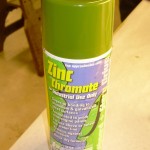
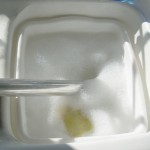

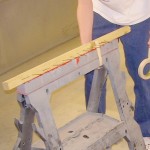
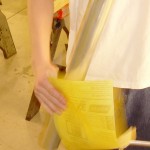
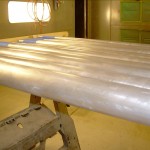

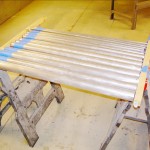
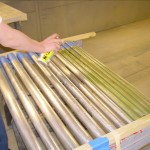
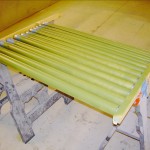
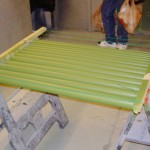
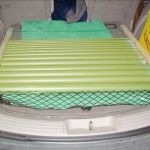
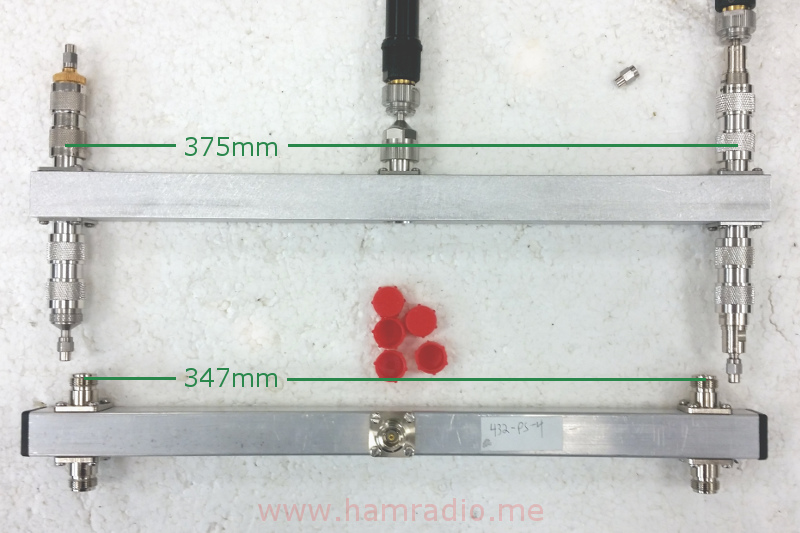
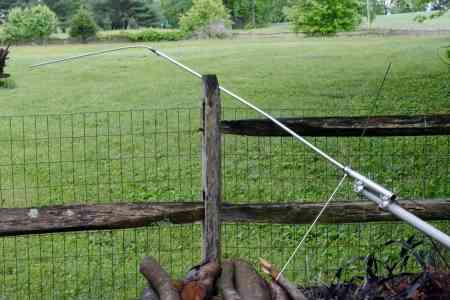
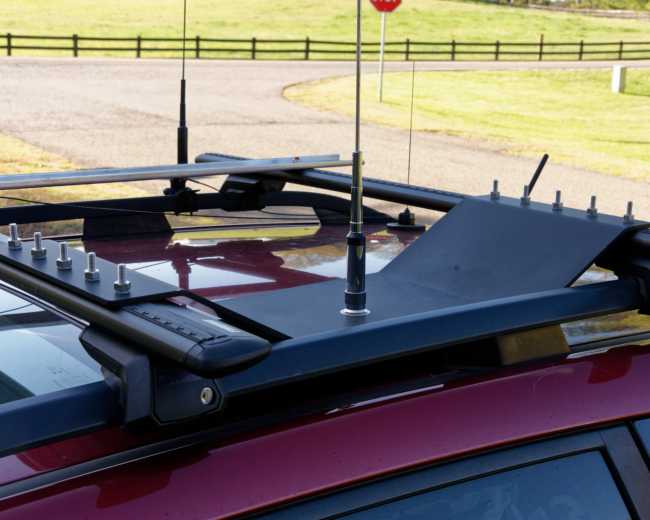
I have purchased a Zero Five antenna and I am wanting to paint it. I was just wondering how your project turned out, and does the paint job seem to have any affect on the performance of the antenna.
Thanks,
Melvin, AB5EQ
Melvin,
Thanks for posting your questions.
After carefully priming the antenna as described above, I applied two coats of generic flat black paint purchased from Home Depot.
Details of the antenna raising are available in this post…
43 Foot Antenna – The Rising
So far the antenna is holding up very well against the weather here in Virginia. There are no signs of paint flake, peel or other issues.
As far as I can tell the antenna performs fine with no perceptible issues caused by the paint. Note my 43 foot antenna is just one big conductor with no traps or anything else. I say this because some paints have conductivity and spraying this across some electrical boundary might cause problems.
My research into Zinc Chromate suggests it does not conduct. However, I was never quite sure. Also black paints typically have carbon in their makeup which might cause them to conduct at DC and/or RF frequencies.
The good news for me and you is our radiating element is just one big conductor mounted on a standoff at the base and should not be perturbed if the paint does conduct. The aluminum will still be the dominant 43 foot conductor and should work just fine. If anyone thinks otherwise I am eager to discuss.
I participate in QRP Fox Hunts on 80 and 40 plus various QSO Parties including the California Party on 80-15 meters with just this antenna. I still wish I had a beam for 20-10, but cannot complain about how this antenna works; It just works.
My primed and painted 43 foot antenna is a keeper.
I wish you the best of luck with yours.
I actually believe that we should paint all of our aluminum antennas, and primer is essential to keep the paint from flaking off over time. When I painted my aluminum antenna I first had it chem-filmed (Alodined). The chem-film process eliminates the oxide layer and prevents it from re-forming before priming. It is also conductive so you don't really need the anti-oxidant goop when fitting the pieces together. That way the primer sticks directly to the aluminum instead of a thin oxide layer, and will last longer.
I've been looking at the alodine, chromate conversion, process as well. How well does this hold up to everyday use?
N9SMJ here. I have spray painted some antennas with green Krylon and or Rust-Oleum. I now want to remove the paint entirely. Any suggestions on this? Both aluminum and PVC antennas. As far as the aluminum, can I bring back some sort of natural shine? Would using automotive re-anodizing work on aluminum? All this is approx 10 years old.
Tnx & 73. Carl Falk. N9SMJ.